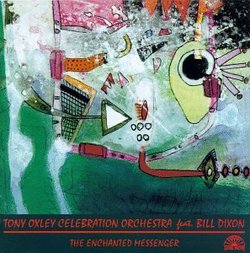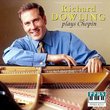| All Artists: Tony Oxley Title: Enchanted Messenger: Live From Berlin Jazz Festiva Members Wishing: 1 Total Copies: 0 Label: Soul Note Records Original Release Date: 10/15/1996 Release Date: 10/15/1996 Album Type: Live Genres: Jazz, Special Interest, Pop Style: Avant Garde & Free Jazz Number of Discs: 1 SwapaCD Credits: 1 UPC: 027312128420 |
Search - Tony Oxley :: Enchanted Messenger: Live From Berlin Jazz Festiva
 | Tony Oxley Enchanted Messenger: Live From Berlin Jazz Festiva Genres: Jazz, Special Interest, Pop
The Enchanted Messenger |
Larger Image |
CD DetailsSynopsis
Album Description The Enchanted Messenger Similar CDs
|
CD ReviewsA Painter's Background dork@sirius.com | 08/18/1998 (5 out of 5 stars) "In past recordings Tony Oxley has demonstrated matchless ingenuity on his instrument as a percussionist. Particularly compelling is his work with the orchestra's featured guest soloist, Bill Dixon. Oxley served as the percussionist for Dixon's quartet in the recording sessions that resulted in the titles "Vade Meccum 1 & 2" (Soul Note) From these recordings it was easy to understand the common ground between these two improvisors. Both have the spontanaety of a young child coupled with the sensibilities and sense of responsibility comparable to that of the most ardent of classical pedagogues. So I was very anxious not only to hear how Oxley fared as the orchestra's leader, but how the orchestra under such leadership cohesed with Dixon. Dixon, though not very well known to the uninitiated, is an institution. He remains THE most distinguished voice on his instrument. He created an entirely new vocabulary for the trumpet utilizing techniques that no one else has been able to decipher. This, plus Dixon's history as an organizer and educator (The October Revolution in Jazz, The Jazz Composer's Guild, The New York University of the Streets, etc.) states for him his dedication to the musical community at large to the same degree his abilities speak for his commitment to his art. His playing on this recording does nothing to discourage the listener from taking it VERY SERIOUSLY. Ben Young states in the liner notes of this recording that what these musicians do in an orchestra is not the culmination of last week's rehearsals, but each musician summarizing decades of experience with each decisive action. The membership is able to anticipate each other VERY WELL and it becomes very obvious to the doubtful that there is nothing arbitrary or incidental about what one is hearing. The orchestra is able to propel itself into dense exchanges right before releasing it as though it never happened. It is hard enough for smaller groups to be able to listen to each other and from that deploy the appropriate response. All the musicians see this task through in fine style. A reviewer in CODA MAGAZINE stated that he felt this recording to be "one of the most interesting and important" to be heard in a while. I would have to agree." Just how many innovative composers are there? greg taylor | Portland, Oregon United States | 09/12/2004 (5 out of 5 stars) "I wanted to add to the most agreeable review below some technical info that might perk the ears. The Celebration Orchestra on this 1994 recording is built around the following instrumentation: 4 percussionists (Joe Thomas, Tony Levin, Stefan Holker, Tony Oxley), 2 reed players (Frank Gratkowski, Ludwig Petrowsky), 2 violins (Phil Wachsman, Alex Kolkowski), 2 celli (Marcio Mattos, Alfred Zimmerlin), 2 electronicists (Matt Wand, Pat Thomas who also plays piano), 1 monster trombone player (Johannes Bauer), voice (Phil Minton) and trumpet (Bill Dixon).
You realize you are in for something different when the first section features the four percussionists in a soli sequence that immediately focuses your attention. Each solo is distinct, subtle and full of ideas. The piece is divided into nineteen subsections. Several of these subsections are "mobiles" where the featured soloists also cues an orchestral subsection as to what to do during their solo. My personal favorite of these is #11 featuring Johannes Bauer as the soloist. His playing throughout this CD is enough to make me want to go back to everything I have with him on it and listen to it again. I simply have not appreciated him enough. There are many other outstanding players- Dixon (of course), both Gratkowsky and Petrowsky are superb (listen to their soli in sections 8 and 9), and Wachsman. But as is suggested by the reviewer below, the real star is the ensemble. These days there is nothing like a standard notation that is being used. A composer like Oxley comes to their rehearsals armed with a score that first needs to be deciphered and an overall architecture that must be explained. Meter, duration, pitch are all somewhat indeterminate. Notice that somewhat. This is not free jazz. This is a conducted composition that allows for input during the performance by the performers. This places an enormous demand on the players. But is also makes for some of the most interesting music of recent years. I have recently written reviews of Cecil Taylor's Owner of the Riverbank and of Butch Morris' Conduction 15. Each of these composers is working in the same broad musical area as well. If you are a fan of those CDs or of the LJCO or of some of Braxton's orchestral works than this CD is for you." |

 Track Listings (19) - Disc #1
Track Listings (19) - Disc #1

